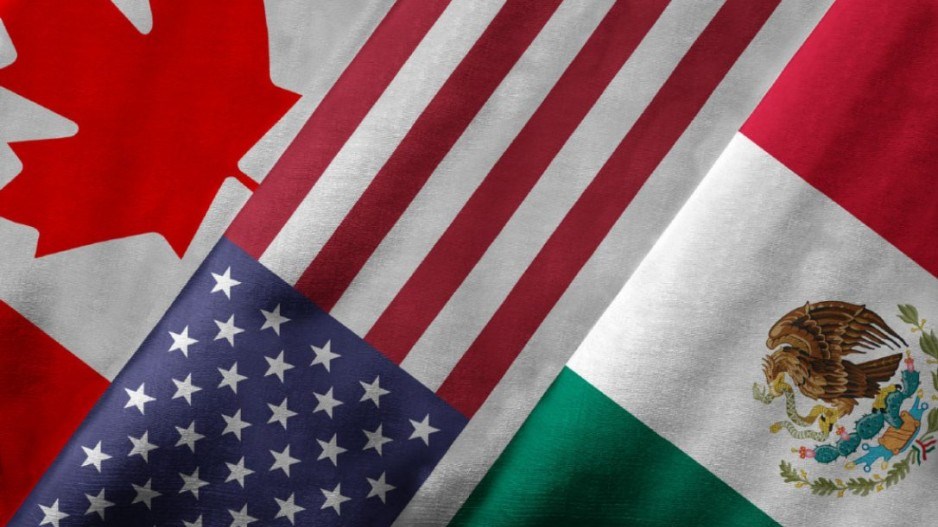While markets appear fond of a new trilateral deal to replace NAFTA, experts are cautioning it won’t solve all the economic woes facing the Canadian export sector.
The S&P/TSX Composite Index was up more than 85 points as of 7:30 a.m. PT on October 1, hours after negotiators announced late the previous evening the new U.S.-Mexico-Canada Agreement (USMCA) had been struck.
The morning rally for the loonie (up 0.80% to trade at US$0.7886) also reflects greater certainty the Bank of Canada will hike rates in the coming months, according to an investors note from CIBC Economics Research.
“But the trade deal is not a cure all for Canada’s export sector,” CIBC economists Avery Shenfield and Katherine Judge wrote in the note.
The pair said they had already assumed a NAFTA resolution would be reached by October, so their current forecasts for the economy remain unchanged.
“The Bank of Canada had imposed a 0.2%-point per year drag on growth from trade uncertainties, but it won’t lift all of that in its next forecast, given that the steel/aluminum issue remains unresolved,” the economists said, referring to the trade dispute between the Canada and the U.S. that began when the Americans applied tariffs onto Canadian steel and aluminum exports, citing concerns over national security.
Ottawa followed up with retaliatory measures.
“It does appear, however, that talks on that issue will ensue, so there’s hope that with a warming of trade relations in the wake of this deal, progress might be made on base metals,” the economists stated.
“The U.S. also agreed that in the future it would give Canada and Mexico advance notice, and a window in which to negotiate, should it find new industries that it wants to subject to these ‘national security’ tariffs.”
But Shenfield and Judge said Canadians shouldn’t expect the rally in the dollar to continue deep into 2019.
They expect the U.S. Federal Reserve will hike rates more aggressively next year than the Bank of Canada, leaving the loonie to trade at rates similar to where it is currently.
Notable highlights from the deal include U.S. dairy farmers gaining access to 3.5% of Canada’s market — a sticking point for U.S. President Donald Trump who complained extensively about Canada’s supply management system.
Meanwhile, the new USMCA deal will retain the dispute resolution mechanism of NAFTA.
This component was a sticking point for Canadian negotiators.
Meanwhile, the new deal is scheduled to last 16 years with a review scheduled after six years.
The three countries can then agree to another 10 years or else begin new negotiations to take place over the ensuing decade.
Online shoppers will also see the De Minimus threshold for duty-free access grow from $20 to $150.
“While Canada has made some concessions, the biggest positive from this deal is that it will remove a massive cloud of uncertainty for policymakers and businesses,” BMO chief economist Douglas Porter wrote in a note to investors.
“While rate hikes will likely stay gradual, the pace may pick up slightly more than previously expected over the coming year. We are now calling for three rate-hikes in 2019 (January, April, and July).”
The Greater Vancouver Board of Trade applauded the agreement, stating in a release that it welcomed putting behind the uncertainty of trade negotiations.
“As a small, open trading economy, British Columbia, and Canada as a whole, needs predictable access to our most critical markets. That means a reliable framework for free trade with two of our most important trading partners: the United States and Mexico,” Iain Black, CEO of the GVBOT, said in a statement.
“In particular, we are pleased to see that the text of the new agreement appears to contain clauses that carry forward the dispute resolution mechanism from NAFTA — a priority for Canada.”
The Surrey Board of Trade’s response was less enthusiastic but still supportive of the new deal.
“Surrey has the greatest number of manufacturers in BC, and one-third of Surrey’s land base is agriculture. We need to review the details of the USMCA agreement. As a border city, we will want to ensure that Surrey businesses are not compromised in this deal,” said Anita Huberman, CEO of the SBOT said in a statement.
“We must also continue to diversify our global markets to protect businesses from uncertainty and reduce our reliance on one market.”




